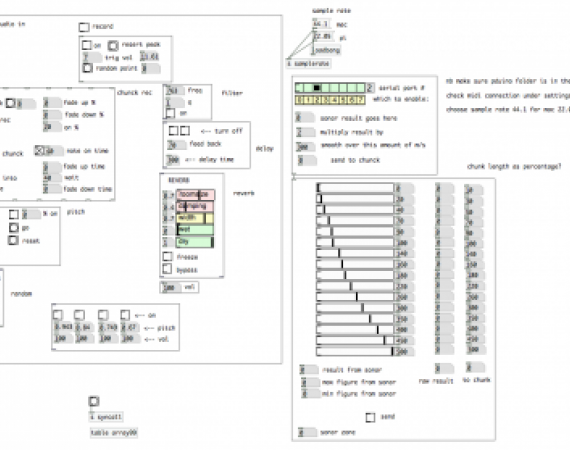Posted on Wed 24 Oct 2012
Pd patch-tastic
Wow – Matt has been super busy with the Pd patching and it’s really good ! It’s possible to get some really interesting sounds, and based on how the Bedford choir performers responded to it - I’ve decided to put more manual controls on the device –so it’s possible to control delay,…

Version of the Pd patch for my laptop
Wow – Matt has been super busy with the Pd patching and it’s really good ! It’s possible to get some really interesting sounds, and based on how the Bedford choir performers responded to it - I’ve decided to put more manual controls on the device –so it’s possible to control delay, reverb and ‘note length’ independently… It’s a shame to have these fixed in a pre-set – so this gives the performers a lot of options for improvising and shaping the sounds live – whilst the sonar sensor determines the note repeat rate.. (and other parameters).
Each setting can now be saved as a ‘preset’ - so it can be recalled and used instantly. All the pre-sets relate to a different phenomena that bats employ when echo –locating to recap – these are the different transformations.
1 – Echo repeat rate - As you get closer to someone, your voice echoes at increasingly faster repeat rates.
2 – More Notes added – as you get closer to someone, the echo repeats start to modulate to different notes to the one you are singing – changing note more frequently the closer you get to someone.
3 – Harmonising – as you get closer to someone, another note is added at the same time as the existing one to build up a chord.
4 – Note bending – your sung note gets modulated slightly higher – the closer you get to someone.
Matt has programmed in some really good controls for setting up the sonar sensor. There are 16 ‘zones’ which are calibrated to the range of the sonar sensor – so zone 16 is furthest away, and zone 1 is closest. This means we can set parameters to change in every zone – OR – parameters that only change from zone 5, or any kind of combination or rate of change. This means there can be higher or lower ‘resolution’ in the way the sonar effects the sound processing…. Another, more controlled way of smoothing the data after it has passed through the ‘strangeness filter’.